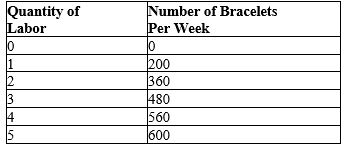B) False
Correct Answer

verified
Correct Answer
verified
Multiple Choice
The marginal product of any factor of production depends on
A) the quantity of the factor used.
B) the price of the final good.
C) the demand for the final good.
D) All of the above are correct.
F) A) and B)
Correct Answer

verified
Correct Answer
verified
Multiple Choice
Which of the following is correct? Using data from 2014,
A) immigrants (both legal and illegal) make up about 40 percent of the U.S. population.
B) low-skilled immigration lowers the earnings of all workers in the United States by about 15 percent.
C) illegal immigrants make up about 20 percent of the U.S. workforce.
D) over 80 percent of immigrants are from Latin America and Asia.
F) A) and C)
Correct Answer

verified
Correct Answer
verified
True/False
A monopsony firm in a labor market hires fewer workers than would a competitive firm.
B) False
Correct Answer

verified
Correct Answer
verified
Multiple Choice
Of the total income earned in the U.S. economy, approximately
A) 33 percent is earned by workers, and 67 percent is earned by landowners.
B) 50 percent is earned by workers, 25 percent is earned by landowners, and 25 percent is earned by owners of capital.
C) 67 percent is earned by workers, and 33 percent is earned by owners of land and capital.
D) 90 percent is earned by workers, and 10 percent is earned by owners of land and capital.
F) C) and D)
Correct Answer

verified
Correct Answer
verified
True/False
If Firm X is a competitive firm in the market for labor, it has little influence over the wage it pays its employees.
B) False
Correct Answer

verified
Correct Answer
verified
Multiple Choice
Suppose that a college physics experiment goes horribly wrong and releases an electronic pulse that renders all electronic equipment in the cities of Columbus, Cleveland and Cincinnati, Ohio permanently useless. No people are hurt, and no buildings are damaged. After the accident, the wages earned by Ohio workers will
A) increase because the marginal productivities of Ohio workers will increase.
B) decrease because the marginal productivities of Ohio workers will decrease.
C) decrease because the marginal productivities of Ohio workers will increase.
D) increase because the marginal productivities of Ohio workers will decrease.
F) A) and D)
Correct Answer

verified
Correct Answer
verified
Multiple Choice
Which of the following statements is correct?
A) Neither economic theory nor evidence from the U.S. economy suggests that there is a close link between productivity and real wages.
B) Economic theory suggests that there is a close link between productivity and real wages, but evidence from the U.S. economy fails to confirm that link.
C) Evidence from the U.S. economy suggests a close link between productivity and real wages, but economic theory provides no basis for such a link.
D) Both economic theory and evidence from the U.S. economy suggest that there is a close link between productivity and real wages.
F) B) and D)
Correct Answer

verified
Correct Answer
verified
Multiple Choice
An increase in the demand for houses
A) increases the equilibrium wage of carpenters and increases the value of carpenters' marginal product of labor.
B) increases the equilibrium wage of carpenters and decreases the value of carpenters' marginal product of labor.
C) decreases the equilibrium wage of carpenters and increases the value of carpenters' marginal product of labor.
D) decreases the equilibrium wage of carpenters and decreases the value of carpenters' marginal product of labor.
F) None of the above
Correct Answer

verified
Correct Answer
verified
Multiple Choice
Table 18-2  -Refer to Table 18-2. The table shows the number of bracelets that can be assembled per week by various numbers of workers. If the price per bracelet in a perfectly competitive product market is $5, how many workers would the firm employ if the weekly wage rate is $375?
-Refer to Table 18-2. The table shows the number of bracelets that can be assembled per week by various numbers of workers. If the price per bracelet in a perfectly competitive product market is $5, how many workers would the firm employ if the weekly wage rate is $375?
A) 1
B) 2
C) 3
D) 4
F) C) and D)
Correct Answer

verified
Correct Answer
verified
Multiple Choice
A competitive firm will hire workers up to the point at which the value of the marginal product of labor equals the
A) average total cost.
B) average variable cost.
C) wage.
D) price per unit of output.
F) All of the above
Correct Answer

verified
Correct Answer
verified
Multiple Choice
Suppose that a large rogue wave destroys the (thankfully unoccupied) fleet of swordfish fishing boats docked in the Gloucester, Massachusetts harbor. What happens to the earnings of fishermen and women in Gloucester?
A) The reduction in the supply of fishing boats increases the marginal productivities of Gloucester fishermen and women, which causes the equilibrium wage to fall.
B) The reduction in the supply of fishing boats reduces the marginal productivities of Gloucester fishermen and women, which causes the equilibrium wage to fall.
C) The reduction in the supply of fishing boats increases the marginal productivities of Gloucester fishermen and women, which causes the equilibrium wage to rise.
D) The reduction in the supply of fishing boats reduces the marginal productivities of Gloucester fishermen and women, which causes the equilibrium wage to rise.
F) A) and D)
Correct Answer

verified
Correct Answer
verified
Showing 581 - 592 of 592
Related Exams